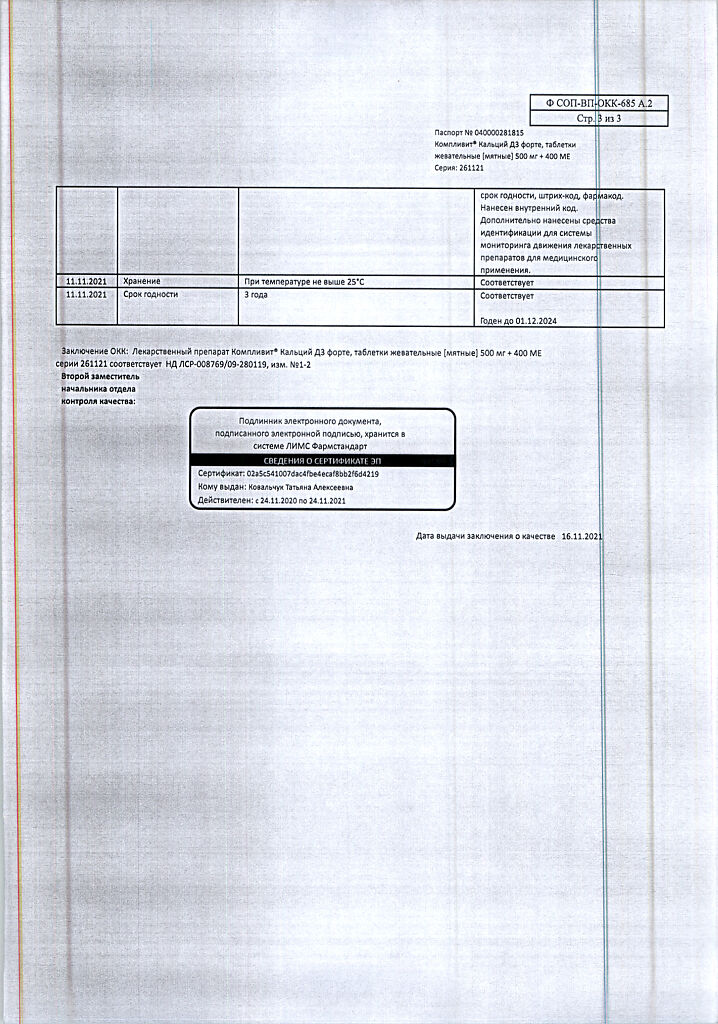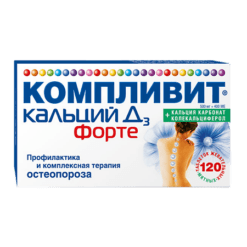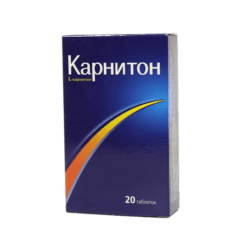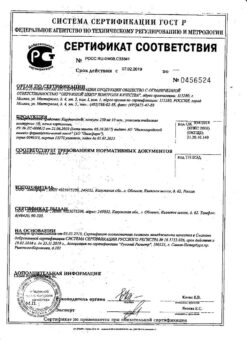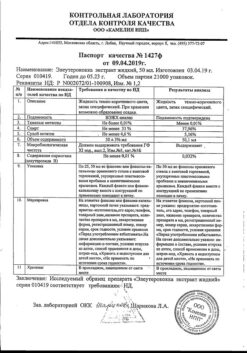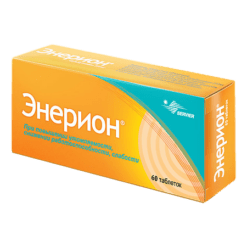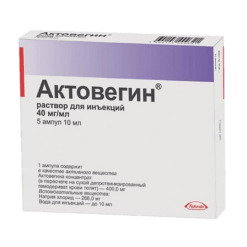No products in the cart.
Complivit Calcium D3 forte, mint 100 pcs.
€19.12 €15.93
Description
Pharmacotherapeutic group: calcium-phosphorus metabolism regulator.
ATC code: [A12AX].
Pharmacological properties
Pharmacodynamics
A combined drug whose action is due to its constituent components. It regulates calcium and phosphate metabolism, decreases resorption and increases bone density, compensates the lack of calcium and vitamin D3 in the body, increases absorption of calcium in intestine and reabsorption of phosphate in kidneys, promotes bone mineralization.
Calcium is involved in the formation of bone tissue, blood clotting, in maintaining stable cardiac activity, in the processes of transmission of nerve impulses.
Vitamin D3 (colecalciferol) – promotes the absorption of calcium in the intestine, the formation and mineralization of bone and dental tissue.
The use of calcium and vitamin D3 prevents increased production of parathyroid hormone, which is a stimulant of increased bone resorption.
Pharmacokinetics
Vitamin D3 is absorbed in the small intestine. Calcium is absorbed in ionized form in the proximal small intestine through an active, D-vitamin dependent transport mechanism.
Indications
Indications
Prevention and complex therapy of osteoporosis (menopausal, senile, “steroidal”, idiopathic) and its complications (bone fractures).
Replenishment of calcium and/or vitamin D3 deficiency.
Pharmacological effect
Pharmacological effect
Pharmacotherapeutic group: calcium-phosphorus metabolism regulator.
ATX code: [A12AX].
Pharmacological properties
Pharmacodynamics
A combined drug whose effect is determined by its constituent components. Regulates the exchange of calcium and phosphates, reduces resorption and increases bone density, replenishes the lack of calcium and vitamin D3 in the body, enhances the absorption of calcium in the intestines and the reabsorption of phosphates in the kidneys, promotes bone mineralization.
Calcium – is involved in the formation of bone tissue, blood clotting, maintaining stable cardiac activity, and in carrying out the processes of transmission of nerve impulses.
Vitamin D3 (colecalciferol) – promotes the absorption of calcium in the intestines, the formation and mineralization of bone and dental tissue.
The use of calcium and vitamin D3 prevents an increase in the production of parathyroid hormone, which is a stimulator of increased bone resorption.
Pharmacokinetics
Vitamin D3 is absorbed in the small intestine. Calcium is absorbed in ionized form in the proximal small intestine through an active, D-vitamin-dependent transport mechanism.
Special instructions
Special instructions
To avoid overdose, additional vitamin D3 intake from other sources must be taken into account.
Complivit® Calcium D3 Forte contains aspartame, which is transformed into phenylalanine in the body, so the drug should not be taken by patients suffering from phenylketonuria.
During the treatment period, it is necessary to constantly monitor the excretion of calcium in the urine and the concentration of calcium and creatinine in the blood plasma (in case of calciuria exceeding 7.5 mmol/day (300 mg/day), it is necessary to reduce the dose or stop taking it).
In older people, the need for calcium is 1500 mg/day, for vitamin D3 – 0.5-1 thousand IU/day.
Active ingredient
Active ingredient
Calcium carbonate, Colecalciferol
Composition
Composition
Calcium 500 mg, (as calcium carbonate) 1.25 g
Colecalciferol (vitamin D3) 0.01 mg (400 IU)
(based on 100% colecalciferol)
(in the form of granulate containing colecalciferol – 0.27%, D,L-alpha-tocopherol – 0.0275%, medium chain triglycerides – 10.7%, sucrose – 36%, acacia gum – 22%, corn starch – 27%, calcium phosphate (E 341) – 0.5%, water up to 100%).
Excipients: lactose monohydrate – 333.118 mg/333.118 mg, povidone (medium molecular weight polyvinylpyrrolidone, povidone K-30) – 68.24 mg/68.24 mg, polysorbate-80 – 0 mg/1.731 mg, potato starch – 18.969 mg/18.969 mg, croscarmellose sodium – 45.713 mg/50.282 mg, citric acid monohydrate – 3.325 mg/3.325 mg, aspartame (E 951) – 5.95 mg/5.95 mg, magnesium stearate – 15.75 mg/15.75 mg, orange flavor – 8.925 mg or peppermint leaf oil – 2.625 mg.
Pregnancy
Pregnancy
The daily dose should not exceed 1500 mg of calcium and 600 IU of vitamin D3. Hypercalcemia,
developing against the background of an overdose, during pregnancy can cause
defects in the mental and physical development of the child. Vitamin D and its metabolites
may pass into breast milk, so intake must be taken into account
calcium and vitamin D from other sources in mother and child.
Contraindications
Contraindications
Hypersensitivity to the components of the drug (including lactose intolerance, lactase deficiency, glucose-galactose malabsorption), hypercalcemia, hypercalciuria, calcium nephrourolithiasis, hypervitaminosis D, decalcifying tumors (myeloma, bone metastases, sarcoidosis), osteoporosis due to immobilization, phenylketonuria (contains aspartame), pulmonary tuberculosis (active form), chronic renal failure, children under 3 years of age.
Use with caution: pregnancy, lactation.
Side Effects
Side Effects
Dyspeptic disorders of the gastrointestinal tract (constipation, flatulence, nausea, stomach pain, diarrhea).
Allergic reactions.
Hypercalcemia and hypercalciuria (increased calcium levels in the blood and urine).
Interaction
Interaction
The activity of vitamin D3 may be decreased when used concomitantly with phenytoin or barbiturates.
During simultaneous treatment with cardiac glycosides, monitoring of the ECG and clinical condition is necessary, since calcium preparations can potentiate the therapeutic and toxic effects of cardiac glycosides.
Calcium and vitamin D3 supplements may increase the absorption of tetracyclines from the gastrointestinal tract. Therefore, the time interval between doses of drugs should be at least three hours.
To prevent decreased absorption of bisphosphonate drugs or sodium fluoride, it is recommended to take Complivit® Calcium D3 Forte no earlier than two hours after taking them.
Glucocorticosteroids reduce the absorption of calcium, so treatment with glucocorticosteroids may require an increase in the dose of Complivit® Calcium D3 Forte.
Simultaneous treatment with cholestyramine preparations or laxatives based on mineral or vegetable oil may reduce the absorption of vitamin D3.
With simultaneous use of thiazide diuretics, the risk of hypercalcemia increases, as they increase tubular reabsorption of calcium. Furosemide and other “loop” diuretics, on the contrary, increase calcium excretion by the kidneys.
Overdose
Overdose
If you notice signs of overdose, consult your doctor.
Symptoms: thirst, polyuria, loss of appetite, nausea, vomiting, constipation, dizziness, weakness, headache, fainting, coma; with long-term use: calcification of blood vessels and tissues.
Treatment: introduction of large amounts of fluid into the body, use of “loop” diuretics (for example, furosemide), glucocorticosteroids, calcitonin, bisphosphonates.
If clinical symptoms of overdose develop, the concentration of calcium and creatinine in the blood should be determined. In case of increased concentration of calcium or creatinine in the blood serum, the dose of the drug should be reduced or treatment should be temporarily stopped.
Storage conditions
Storage conditions
At a temperature not exceeding 25 °C. Keep out of the reach of children.
Shelf life
Shelf life
3 years.
Manufacturer
Manufacturer
Pharmstandard-UfaVITA, Russia
Additional information
| Shelf life | 3 years. |
|---|---|
| Conditions of storage | At a temperature not higher than 25 ° C. Keep out of reach of children. |
| Manufacturer | Pharmstandard-UfaVITA, Russia |
| Medication form | chewable tablets |
| Brand | Pharmstandard-UfaVITA |
Other forms…
Related products
Buy Complivit Calcium D3 forte, mint 100 pcs. with delivery to USA, UK, Europe and over 120 other countries.




